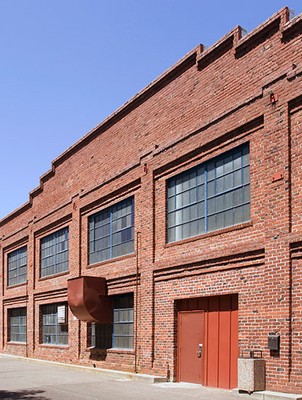Blue Diamond Building and Historical Marker
Introduction
Text-to-speech Audio
Constructed in 1925, the Blue Diamond Building was originally constructed by the California Packing Corporation as Calpak Plant No. 11, a fruit canning facility used by Del Monte Foods. The brick building remained one of the last operational canneries in the City of Sacramento until its closure in 1932. The old cannery building was renovated in 1983 to become the International Visitors Center and Almond Plaza for Blue Diamond Growers, a co-operative association of California almond farmers founded in 1910. The Blue Diamond Building is located next to another historic building that serves as the Blue Diamond almond processing plant. Recognized for its architectural significance, and also for its importance in California's agricultural history, the Blue Diamond Building was added to the National Register of Historic Places in 1984.
Images
Blue Diamond Building Historical Marker

Blue Diamond Building (International Visitors Center)

The Blue Diamond Building was formerly the CalPak Plant No. 11

CalPak Plant No. 11, as it appeared in 1984

CalPak Plant No. 11, as it appeared in 1984

Backstory and Context
Text-to-speech Audio
Between 1860 and 1890, several small packing and canning companies were launched in the Bay Area and Sacramento region. These companies packed and canned products under a variety of brand names, with goods shipped to communities in California and the Pacific Northwest. In the 1890s, Del Monte Foods became one of the most well-known brands in California. Although the brand name was first used by the Oakland Preserving Company, by 1899, Del Monte had also been chosen as a premiere brand of the California Fruit Canners Association.
After the opening of the Panama Canal in 1914, California emerged as a leader in the national canning industry, as goods could be shipped more easily with rates that were competitive with railroad freight. In 1917, as California’s agricultural industry expanded along with its canning industry, the California Packing Corporation launched an advertising campaign under the Del Monte brand. The Del Monte logo featured an image of the high-end Hotel del Monte in Monterey, California, associating the brand with quality. By the 1920s, the Del Monte brand had obtained an international reputation, which further encouraged the sale and growth of California agricultural products worldwide.
In 1925, the California Packing Corporation constructed CalPak Plant No. 11 in Old Town Sacramento as a fruit cannery for Del Monte Foods. From the time of its construction, this brick building was one of the largest canneries in the world. Because of its size, and because Sacramento was located in the heart of an agricultural region with a strong transportation system, the city itself became known as “the Cannery of the West.” At CalPak Plant No. 11, workers packed California produce including tomatoes, peaches, pumpkins, squash, beets, spinach, and carrots, as well as pears that arrived by steamboat from the Delta. The plant remained the last operational cannery in Sacramento until its closure in 1932.
In 1983, the old cannery building was repurposed by Blue Diamond Growers as an International Visitors Center, officially known as the Blue Diamond Building. Blue Diamond Growers evolved from the California Almond Growers Exchange, a co-operative production and marketing association established in 1910. Today, the group consists of almond growers from 3,000 farms throughout the state. These farmers produce the flagship Blue Diamond brand of almonds, among other products which are shipped around the world. Similar to California’s canning industry, the almond industry in California has contributed significantly to the state's economic and agricultural growth.
The Blue Diamond Building was listed on the National Register of Historic Places in 1984. A historical marker placed at the site notes that the international flags in front of the building represent the countries of visiting dignitaries and customers, and that almonds are the state's largest food export. A major renovation of the Blue Diamond Building was completed in 2017 by Dreyfuss + Blackford. It currently contains a historic packing facility, a Nut & Gift Shop, an employee theater, and administrative offices. Historic features have been preserved, including the building’s exposed brick walls, wood trusses, and clerestory windows that allow ample light to enter.
Sources
"California SP Calpak Plant No. 11", National Archives. April 18th, 1984. Accessed July 29th, 2023. https://catalog.archives.gov/id/123860557.
"Dreyfuss + Blackford reconfigures three historic buildings creating 26,600 square feet of improved employee work environments", Dreyfuss Blackford. Accessed July 29th, 2023. https://www.dreyfussblackford.com/press-release/blue-diamond-growers-renovates-restores-historic-buildings-in-downtown-sacramento/.
"National Register #84000939: CalPak Plant No. 11 / Blue Diamond Building", Noe Hill. August 13th, 2006. Accessed July 29th, 2023. https://noehill.com/sacramento/nat1984000939.asp.
Whittle, Syd. "Blue Diamond Almonds Building", Historical Marker Database. September 28th, 2008. Accessed July 29th, 2023. https://www.hmdb.org/m.asp?m=11865.
Syd Whittle, Historical Marker Database
Noe Hill
Noe Hill
Nomination Form, National Register of Historic Places
Nomination Form, National Register of Historic Places
